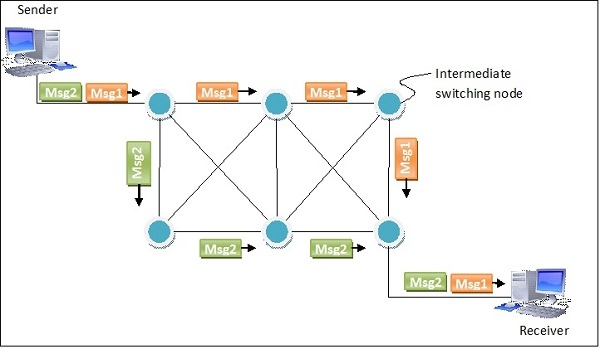
 Data Structure
Data Structure Networking
Networking RDBMS
RDBMS Operating System
Operating System Java
Java MS Excel
MS Excel iOS
iOS HTML
HTML CSS
CSS Android
Android Python
Python C Programming
C Programming C++
C++ C#
C# MongoDB
MongoDB MySQL
MySQL Javascript
Javascript PHP
PHP
- Selected Reading
- UPSC IAS Exams Notes
- Developer's Best Practices
- Questions and Answers
- Effective Resume Writing
- HR Interview Questions
- Computer Glossary
- Who is Who
Message Switching
Message switching is a connectionless network switching technique where the entire message is routed from the source node to the destination node, one hop at a time. It was a precursor of packet switching.
Process
Packet switching treats each message as an individual unit. Before sending the message, the sender node adds the destination address to the message. It is then delivered entirely to the next intermediate switching node. The intermediate node stores the message in its entirety, checks for transmission errors, inspects the destination address and then delivers it to the next node. The process continues till the message reaches the destination.
In the switching node, the incoming message is not discarded if the required outgoing circuit is busy. Instead, it is stored in a queue for that route and retransmitted when the required route is available.This is called store and forward network.
The following diagram represents routing of two separate messages from the same source to same destination via different routes, using message switching −

Advantages and Disadvantages of Message Switching
Advantages
Sharing of communication channels ensures better bandwidth usage.
It reduces network congestion due to store and forward method. Any switching node can store the messages till the network is available.
Broadcasting messages requires much less bandwidth than circuit switching.
Messages of unlimited sizes can be sent.
It does not have to deal with out of order packets or lost packets as in packet switching.
Disadvantages
In order to store many messages of unlimited sizes, each intermediate switching node requires large storage capacity.
Store and forward method introduces delay at each switching node. This renders it unsuitable for real time applications.

